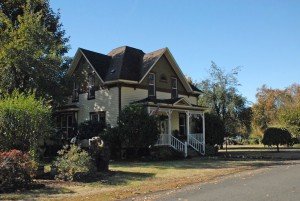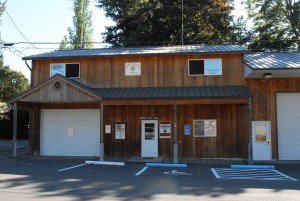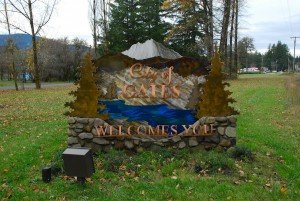 |
| A 1901 home reflecting Gates’ heritage |
Gates has been a community of welcome since 1880. In that year, Albert and Mary Gates, who had settled on 80 acres that today include the present downtown, opened their home as the Pioneer House. It began as a hotel for the railway workers on the proposed Willamette Valley & Coast Railroad (Oregon Pacific). When another settler refused to donate land to the railroad, Mary Gates gave sufficient land for a Y, a depot and a section house. The railway company used the name Gatesville and so the city began. In 1888, the year the rail line was completed, Harrison and Lulu Smith incorporated the Kings Prairie and Quartzville Wagon Road. A subsequent mining boom brought Gates additional hotels, assay offices, stores and related businesses.
The location of the community, along both sides of the North Santiam River caused at least two problems. The covered bridge used by school children was built too close to the water and washed out in 1887. Everyone returned to using the “ferry”: a bucket arrangement on a high cable. The next permanent covered bridge was lifted by a high wind in 1901 and set down on the river bottom. Today’s modern bridge, dividing the city between Marion and Linn counties faces no such hazards.
The name of the local post office was a subject of controversy. The one established in 1882 on the south side of the Santiam River was named Henness, to honor the first postmaster Jane Henness. The name was changed to Rock Creek in 1883. About 1892, W. R. Robertson, then postmaster, moved the post office to the north side of the river to “Gatesville” and the name was changed to Gates, to honor Mary Gates. According to Mrs. J. P. McCurdy, postmaster in 1925, “There was much opposition to the adoption of the new name of Gates by the older settlers who wished to retain the name Rock Creek, A petition was signed to keep the old name. The party circulating the petition got drunk and lost it, therefore the name Gates remained.”
Gates continued being a boom town into the early 1900s, supplying the mines and there are still lost mines in the area. As typical of the rough justice of early western towns, Gates had a “High Noon shoot-out on May 7, 1909, said to have been caused by too much drink. Two men died and the woman in the case left town.” A medical emergency hit the community that fall: an outbreak of typhoid effected many residents of Gates. However, that emergency passed and a civic spirit arose with several fraternal orders established in area: the Odd Fellows and Rebekahs, Ancient Order of United Workers, the Masonic Lodge, Eastern Star, Maccabees and the Women’s Benefit Association.
Fires were always a special hazard in pioneer communities with wooden buildings: a major blaze on February 1939 destroyed the city’s business district. By the next year, they were rebuilt and electricity reached Gates for the first time. The city was incorporated in 1950.
Gates was featured 37 years later in a Statesman Journal article of July 26, 1987 titled “Museum Auction Draws Hundreds”. It describes the auction of collectibles by Velma Haley and her late husband Paul. She decided to put the museum and it contents up for sale after her husband died that May. The proceeds were to finance her retirement. The museum had been closed the last eight years because of vandalism and increased insurance costs. Marion County Deputy Bernie Papenfus said a deputy was stationed in Gates to assist with traffic snarls caused by the swell of people. Residents said they were glad to see the auction take place because it gave them an opportunity to view the artifacts. Such a local museum would be a treasure today.
 |
| City Hall |
The “downtown” section of Gates is on both sides of the highway, but to the west you will find the municipal services. By mid-October we had learned to arrive in a Marion County city on a weekday, not the weekend, and to make our first contact the City Hall. We were fortunate in Gates: Judy Downer, the City Recorder, offered us to a tour. We piled into her car and she drove us around, pointing out the city features. These include the attractive little cottage-style post office and community art center, the western-style City Hall, an architecturally handsome new fire station that also serves as a community meeting place, and the new water plant. We found many riverfront homes are on this Marion County side of the river, including two examples of historic architecture. Driving east on Riverview Street, we crossed the new bridge, replacing those past structures that collapsed or were flooded out, into Linn County. Here we glimpsed farm residences and wide fields, a horse camp, the emergency airstrip, several churches, the historic school and cemetery.
 |
| Welcome to Gates |
Of especial interest on the Linn County side are three sites. First, a dirt-track airstrip, decorated along the edge with a two abandoned airplanes. Next, the historic schoolhouse which is unfortunately closed this year with the local students bused to Mill City. And, at the end of our tour, we visited the beautiful Fairview Cemetery on Gates School Road. It has a recently constructed roofed pavilion that acts as a resource for locating graves. Judy pointed out that in winter, when there is snow, the elaborate headstones appear as ghostly chessmen on a giant board. Mount Horeb acts as a dramatic background for photographs. (For more information, see “Fairview Cemetery/King’s Prairie Burying Ground, 1883-1983.” Author, Cheryl Smith Copeland. Copies available at Salem Public Library and Oregon State Library.)
Gates is on Highway 22, 35 miles east of downtown Salem and there is a beautiful welcome sign to your right at the main entrance to town. Several businesses on the highway: a restaurant, market, wood carving business and ~ best of all ~ a motel, the only one between Stayton and Detroit as you drive east. Gates plans a Christmas celebration around the new city park gazebo. Today, with a size of .6 square miles and a population of 471, the city supports over 200 households where we found out the community spirit is neighborly, despite the separation by the North Santiam River. Gates is definitely a place to stay ~ whether for an hour’s visit, overnight, or as a country residence.
Two additional sources of information about Gates are the North Santiam Chamber of Commerce visitors guide (which can be picked up at the Gates post office) and the Canyon Weekly, available by subscription through the online edition.
An added attraction: One mile east of Gates (37 miles from Salem) on Highway 22 is the 71 acre Minto Park with a one mile forest trail along the North Santiam. There are picnic tables with an overhead view of the river and 2 shoreline places to fish for steelhead or trout. Open 8 a.m. to sunset, but closed in the winter months.
Each Tuesday, after a city was featured in that Sunday’s Statesman Journal, KMUZ broadcasted “Marion County 20”. To learn more about Gates, listen to the podcast as listed on the KMUZ archives.

4 Comments